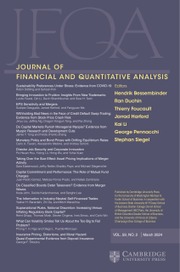Crossref Citations
This article has been cited by the following publications. This list is generated based on data provided by
Crossref.
Ezzell, John R.
Miles, James A.
and
Mulherin, J. Harold Harold
2001.
Is There Really a When-Issued Premium?.
SSRN Electronic Journal ,
Huang, Gow-Cheng
Liano, Kartono
and
Pan, Ming-Shiun
2002.
Do Stock Splits Signal Future Profitability?.
SSRN Electronic Journal ,
Byun, Jinho
and
Rozeff, Michael S.
2003.
Long‐run Performance after Stock Splits: 1927 to 1996.
The Journal of Finance,
Vol. 58,
Issue. 3,
p.
1063.
Dorn, Daniel T.
2003.
Does Sentiment Drive the Retail Demand for IPOs?.
SSRN Electronic Journal ,
Angel, James J.
Brooks, Raymond M.
and
Mathew, Prem G.
2004.
WHEN‐ISSUED SHARES, SMALL TRADES, AND THE VARIANCE OF RETURNS AROUND STOCK SPLITS.
Journal of Financial Research,
Vol. 27,
Issue. 3,
p.
415.
Bechmann, Ken L.
and
Raaballe, Johannes
2005.
The Differences Between Stock Splits and Stock Dividends - Evidence from Denmark.
SSRN Electronic Journal,
Hardin, William G.
Liano, Kartono
and
Huang, Gow-Cheng
2005.
REIT Stock Splits and Market Efficiency.
The Journal of Real Estate Finance and Economics,
Vol. 30,
Issue. 3,
p.
297.
Kadapakkam, Palani-Rajan
Krishnamurthy, Srinivasan
and
Tse, Yiuman
2005.
Stock Splits, Broker Promotion, and Decimalization.
Journal of Financial and Quantitative Analysis,
Vol. 40,
Issue. 4,
p.
873.
Bechmann, Ken L.
and
Raaballe, Johannes
2007.
The Differences Between Stock Splits and Stock Dividends: Evidence on the Retained Earnings Hypothesis.
Journal of Business Finance & Accounting,
Vol. 34,
Issue. 3-4,
p.
574.
Michayluk, David
2009.
Dividends and Dividend Policy.
p.
325.
Bandyopadhyay, Pia
Hackard, James
and
Tse, Yiuman
2010.
The effect of stock splits on iShare exchange‐traded funds.
Managerial Finance,
Vol. 36,
Issue. 2,
p.
134.
Huang, Gow-Cheng
Liano, Kartono
and
Pan, Ming-Shiun
2011.
REIT Stock Splits and Liquidity Changes.
The Journal of Real Estate Finance and Economics,
Vol. 43,
Issue. 4,
p.
527.
Renneboog, Luc
and
Spaenjers, Christophe
2011.
The Dutch Grey Market.
De Economist,
Vol. 159,
Issue. 1,
p.
25.
Smith, Brian F.
and
Zhu, Yunhua
2011.
The impact of stock split handling rules on returns: Evidence from Canada.
Canadian Journal of Administrative Sciences / Revue Canadienne des Sciences de l'Administration,
Vol. 28,
Issue. 1,
p.
70.
Brooks, Raymond M.
and
Yang, J. Jimmy
2012.
Emerging from Bankruptcy with When‐Issued Trading.
Financial Review,
Vol. 47,
Issue. 3,
p.
445.
Chang, Eric C.
Luo, Yan
and
Ren, Jinjuan
2014.
Ex-Day Returns of Stock Distributions: An Anchoring Explanation.
SSRN Electronic Journal,
Brooks, Raymond M.
Kim, Yong H.
and
Yang, J. Jimmy
2014.
What Makes When‐Issued Trading Attractive to Financial Markets?.
Financial Markets, Institutions & Instruments,
Vol. 23,
Issue. 5,
p.
245.
Huang, Gow-Cheng
Liano, Kartono
and
Pan, Ming-Shiun
2015.
The effects of stock splits on stock liquidity.
Journal of Economics and Finance,
Vol. 39,
Issue. 1,
p.
119.
Birru, Justin
2015.
Confusion of Confusions: A Test of the Disposition Effect and Momentum.
The Review of Financial Studies,
Vol. 28,
Issue. 7,
p.
1849.
Devos, Erik
Elliott, William B.
and
Warr, Richard S.
2015.
CEO opportunism?: Option grants and stock trades around stock splits.
Journal of Accounting and Economics,
Vol. 60,
Issue. 1,
p.
18.

